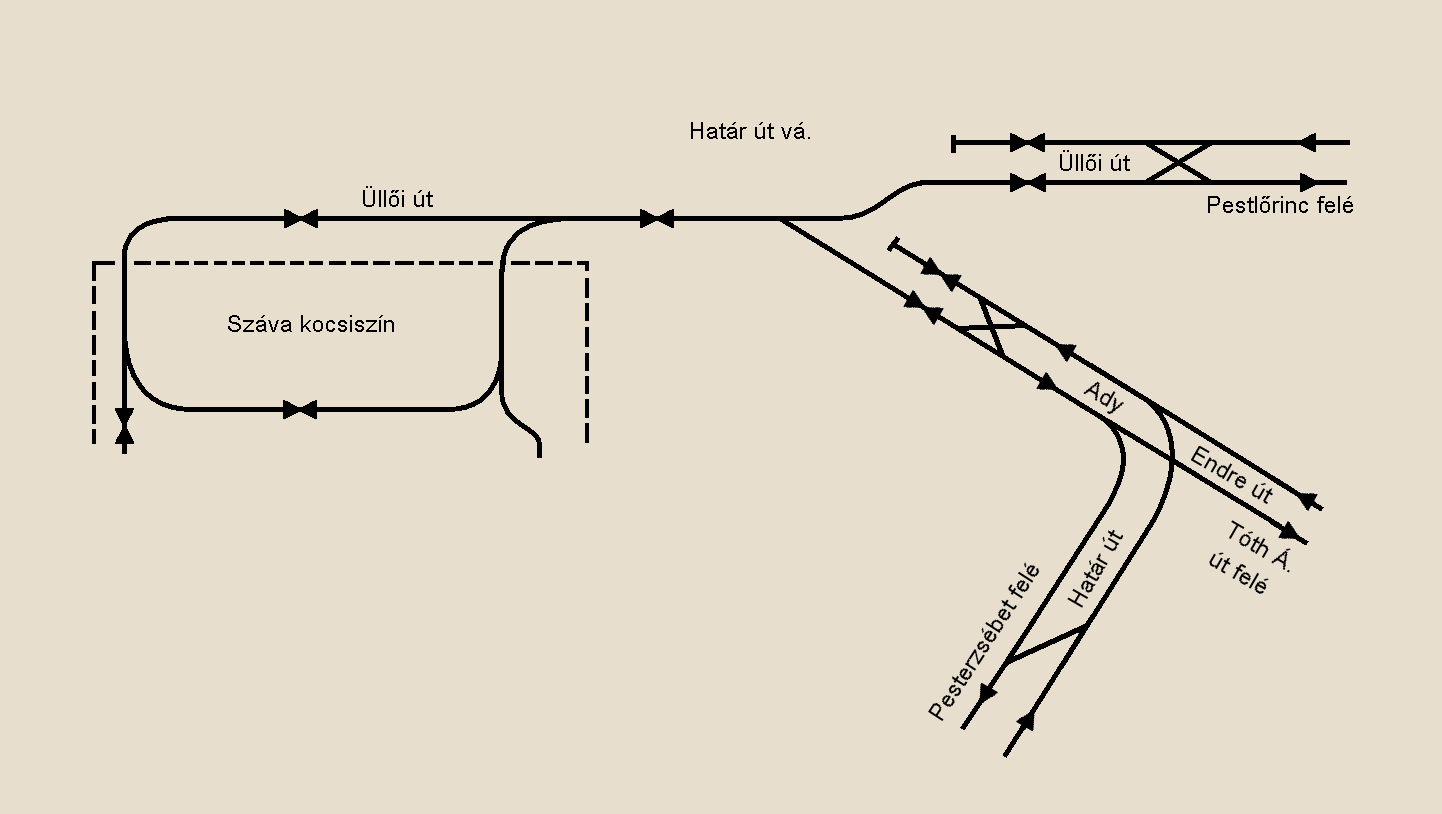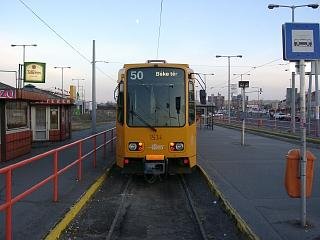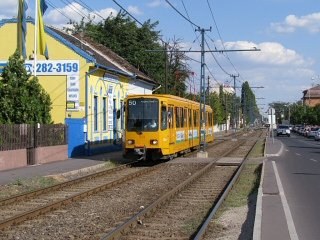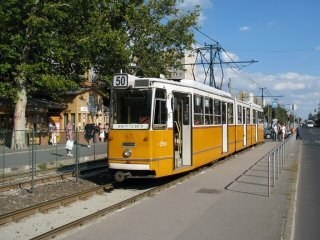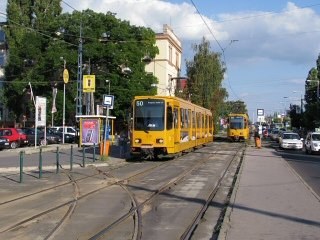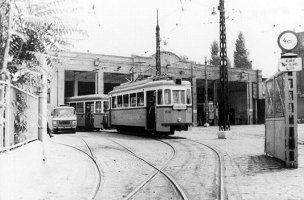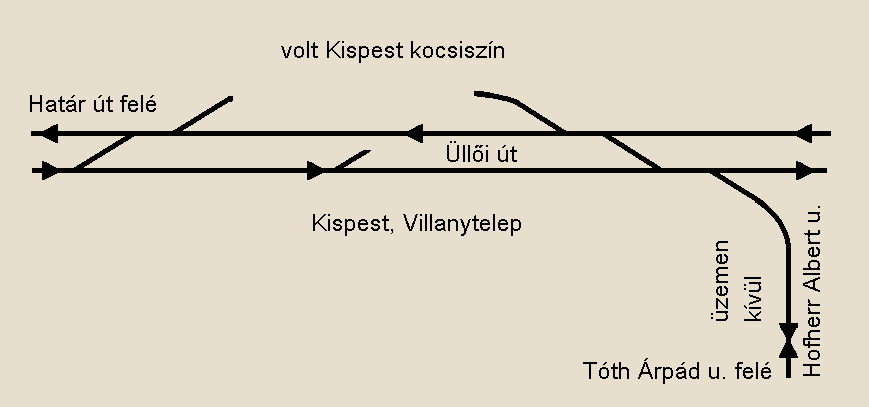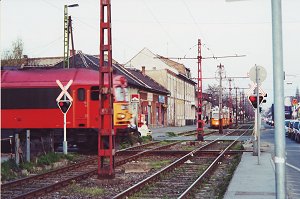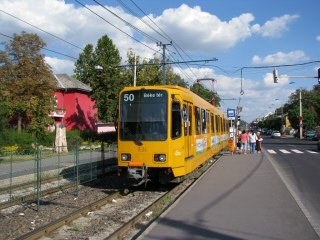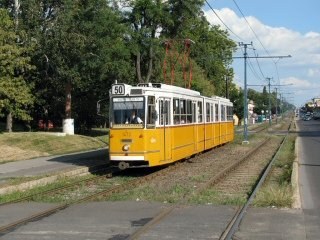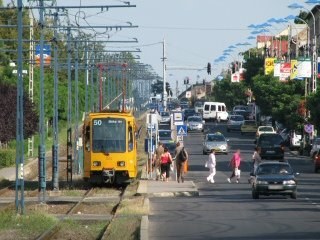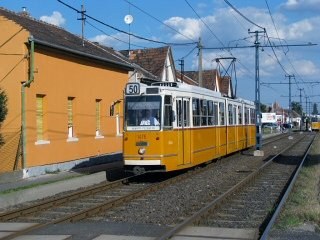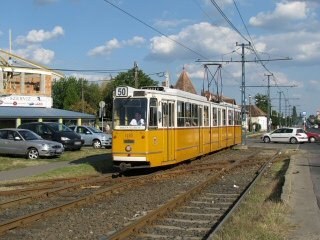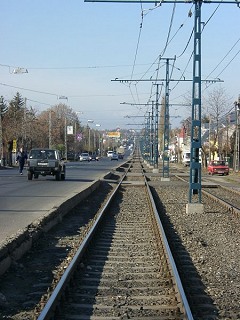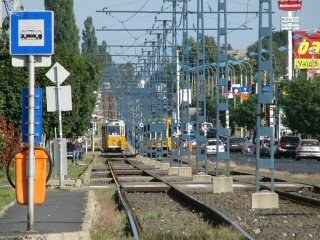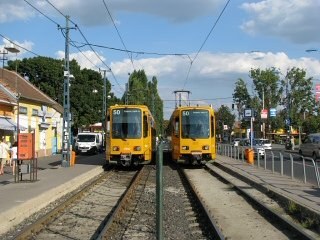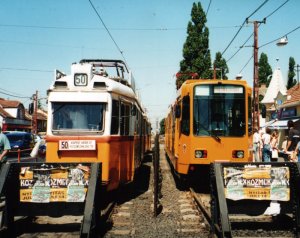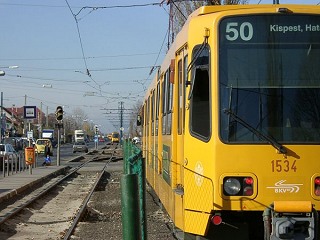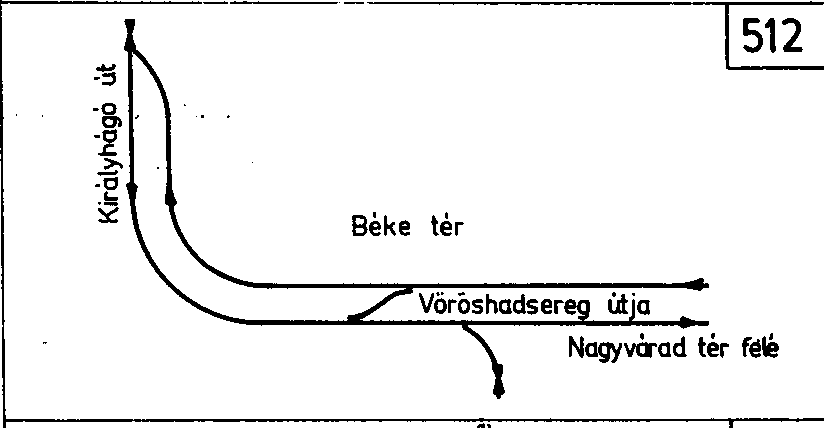Like a number of radial tram routes in Budapest (e.g. route 12 and 14 or 41 and 47), route 50 has started its life as a vicinal railway, operated by a non-municipal company. It was opened between today's Nagyvárad tér and the Pestszentlőrinc brickyard in 1887, with steam traction on a single track (with passing loops) of 760-mm-gauge. The line was a success, so the operating company wanted to build a second track, but the Budapest authorities only gave permission for that if they rebuild the already existing tracks to normal gauge. This was done after the "Corporation for Electric Trams and Transportation Companies" (RVKVSz, nicknamed "The Trust") took over the original operating company. As one would imagine hearing the rather long name of this corporation, they also built out electric traction with 550 volts, and the reborn railway re-launched service in 1900. The line was extended to Szarvas csárda, and a branch-line was also built: it's now nown as tram line 42.
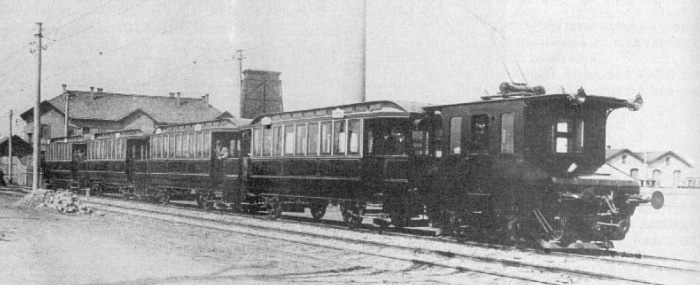
Photo from villamosok.hu,
from the collection of Zoltán Ádám Németh
The operating company, BLVV bought Ganz motorcars with similarly-built trailers, but also used long "workers trains" consisting of four trailers towed by a small electric loco called a "frog". Such a train is depicted above. Below we see a characteristic tram set of Ganz cars. Some of these cars have survived until the late 1970s!

Photo from villamosok.hu,
from the collection of Zoltán Ádám Németh
The BLVV cleverly contracted one of the two municipal tramway companies, BVVV, so their trains reached the inner city from 1913 over the latter's lines. In 1929 the main line reached its current outer terminius, then called Vecsési határ ("the border to Vecsés"). Meanwhile the company pioneered the usage of twin-sets, and in 1930 they also bought multiple-unit mid-entrance Ganz trams:
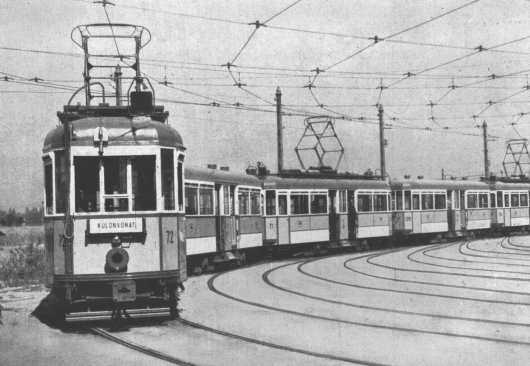
Photo from villamosok.hu,
from the collection of Zoltán Ádám Németh
Although BLVV remained a separate legal entity until 1949, operation was done by the joint municipal transportation company BSzKRt from earlier on. One of the many signs of this was the first articulated tram in Budapest in 1938, converted out of 2-axle trams by the engineers of the BSzKRt:
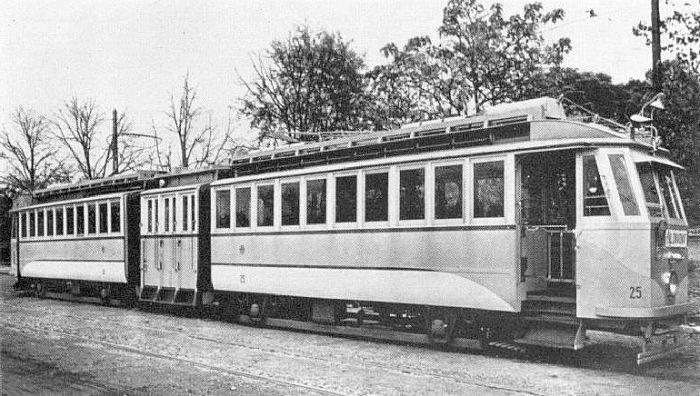
Photo from villamosok.hu,
from the collection of Zoltán Ádám Németh
After 1949 the company lost its own character as Kispest and Pestszentlőrinc have became part of Budapest in 1950 (although they still bear a bucolic atmosphere, especially at the outer end). The most important changes occured in 1976 and 1980, when the M3 metro line was inaugurated between Deák Ferenc tér and Nagyvárad tér and Nagyvárad tér and Kőbánya-Kispest. From 1980 the tram routes 50 and 42 both have their inner termini at Határ út.
If I may say so, route 50 is not the most interesting tram line I've ever seen. It just goes 8 kilometers almost dead-straight, with too much stops, and without any touristic landmarks underway. Despite, for the hardcore tram maniacs there are a few interesting spots: a level crossing with a state railway line, another one with a mostly-unused freight railway line, a disused tram depot converted into a supermarket, and a rarely-used connecting track leading to the terminus of route 42.
Here's
a Google Maps overview of the vicinity:
Switch to a larger map
Route 50:Kispest, Határ út (Határ út M) - outer Üllői út - Pestszentlőrinc, Béke tér (7.9 km)
Vehicles: 19 x TW6000
or Ganz CSMG2 articulated tram
Depot: Száva
Timetable of route 50 on the BKV website
![]()
This place was always a mess as far as I can remember, but since one side of it was torn down to make room for a mall which hasn't been built then (and probably will never be built either), it's very for from being a tourist attraction. And the warning "be mindful of pickpockets" is also justified.
The connecting track leading to the nearby tram depot Száva is rarely used by anything else than tram 50s going out to or coming back from service, and the terminus itself is also quite simple.
You will notice the strange nature of the outer Üllői út: it's like the main street of a small village, which was partially "bombed out", with the old one-story houses been replaced by ten-story-high concrete blocks. Most of the factories along the streets have closed their doors after 1990, also leaving some scars. Still, if you look hard, you can find atmospheric sceneries showing the place nicer than it is in reality :)
"Villanytelep" means "electric yard". Yes, you've guessed it: this was the powerhouse and depot for the electrified vicinal railway.
The forefront of the depot also acted as the terminus for the insection route 50A, and you can still make out some remnants of it.
| Lost
rails: depot Kispest This old depot last housed trams in the early 1980s, and was sold by the BKV after 1990. Now it's a supermarket, but at least the buildings were preserved. |
I think the main attraction of the line is the level crossing after the Hofherr Albert utca turnout:
There aren't many places in Budapest where you can take a photo of a diesel engine and a tram at the same time :) If you'd like to make such photos, this is state railway line number 142 (Kőbánya-Kispest - Lajosmizse - Kecskemét), and the station just a few hundred meters away is called Kispest - you can calculate arrival times of trains from the MÁV on-line schedules.
The rest gets more and more bucolic, though there are a few high-rise blocks here and there.
When you're travelling with the tram, you might not notice, but this line is not exactly flat:
There are two long (therefore not very steep) ascents: one before Szarvas csárda, and one before the last stop.
There's a stop along the line called "Iparvasút". This name translates to "Industrial railway". As the name says, you won't see passanger trains here. In fact chances are that you won't see any trains, as parts of the line were dismantled recently.
Interestingly the railway was called "the Burma railway", and nobody's sure why. It connected the station Szemeretelep on the main line to Szolnok with Soroksár on the main line to Kelebia, also touching the line to Lajosmizse inbetween, as a by-pass during war-time, should the main branch-point Ferencváros become unusable. I believe there might be one company around here using this connection to Szemeretelep, but I've got this information a few years ago, so it might not be the case anymore.
Before the outer terminus, there's another slope.
The terminus at Béke tér ("béke" means "peace", so the place has nothing to do with Béke tér along tram 14) is a simple stub one with a scissors crossover:
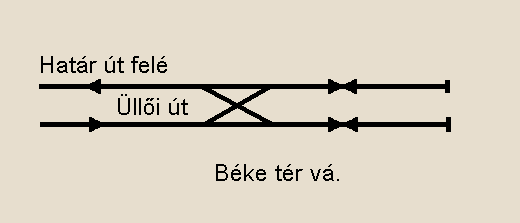
Map by Balázs Fehér
In would say terminus is a nice place. It really looks and feels like a small village, pretty much like Kossuth utca in Rákospalota.
To the left: the first public TW6000-ride on July 13, 2001. Since then the ex-Hannover trams have completely supplanted the UVs.
| Lost
rails: route 40
Tram 40 was probably the strangest line in Budapest. It was built in 1947 (Béke tér-Deák Ferenc utca) and 1950 (extension to Vasút utca), partially by local residents. The neighbourhood was built in at the time, and in order to have some transportation, the people living there took part in preparing the trackage, raising overhead posts, etc! Too bad that this single-track line - considered obsolete in favour of buses - was closed in 1975! And now a request: if you have photos of tram line 40 and are willing to share them, please write! There are only very few photos of this interesting line, and most of them are of inferior quality. It would be really nice to change that! |
![]()
Back to the top
Back to the
opening page
Back
to the clickable map
Disclaimer: The
author cannot be held responsible for mistakes, misinterpretations, inaccuracies,
inactualities, etc. on/of these pages, nor for the content of other pages
linked in.
Archive photos: from the collection
of Dr. Zoltán Ádám
Track layout drawings: FVV, BKV
(collection of Dr. Zoltán Ádám Németh), Fejes Balázs
![]()
Send
a mail to the author
The
author's homepage
